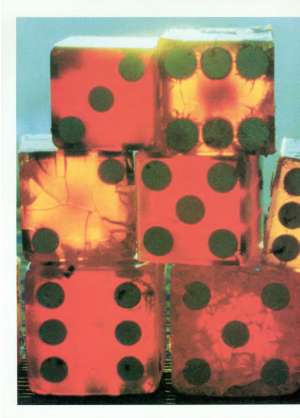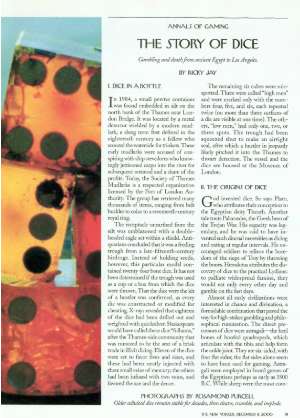The New Yorker, December 11, 2000 P. 90
ANNALS OF GAMING about dice. . . Writer describes the discovery of antique loaded dice in the mud of the Thames. . . The vessel and the dice are housed at the Museum of London. . . God invented dice. So says Plato, who attributes their conception to the Egyptian deity Theuth. . . The direct precursors of dice were astragali—the heel bones of hoofed quadrupeds, which articulate with the tibia and help form the ankle joint. They are six-sided, with four flat sides; the flat sides alone seem to have been used for gaming. . . Amid the detritus under the mounds of ash, soot, and dirt excavated at Pompeii and Herculaneum were found dice. Two major gambling histories published in the nineteenth century claim that these dice were "loaded," weighted to make certain numbers appear more frequently than chance or statistics dictate. Yet, among scores of classical citations, neither tome gives a specific source for this information. . . The Romans were fond of dice: Augustus, Domitian, Commodus, Caligula, and Nero were all inveterate players. Claudius, a flamboyant gambler, wrote a treatise on how to win at dice, which has unfortunately not survived, but the extent of his passion for gaming may be deduced from a feature of his chariot: a specially constructed board stabilized for play on the roughest rural roads of the empire. . . In the sixteenth century, dicing was virtually synonymous with cheating. Robert Greene, the colorful Elizabethan pamphleteer who called Shakespeare an "upstart crow," and who expired ignominiously after a surfeit of pickled herring, defined Cheating Law as "play at false dice.". . . Mentions the dwarf dice operator, Matthew Buchinger. . . According to Gilbert Walker, in sixteenth-century London false dice could readily be obtained in the prisons of Marshalsea or King’s Bench... Walker extolled the workmanship of Bird of Holborn, the first such craftsman known by name. . . Such objects of deception are still offered for sale, often under the guise of conjuring supplies sold "for entertainment purposes only." A handyman hustler in the nineteen-forties did not have to rely on shop-crafted wares but could fashion his own false dice with the equipment outlined in a catalogue issued by a Los Angeles firm. . . Writer describes the deterioration of his cellulose-nitrate dice collection, a process being documented by Massachusetts photographer Rosamond Purcell. . .

